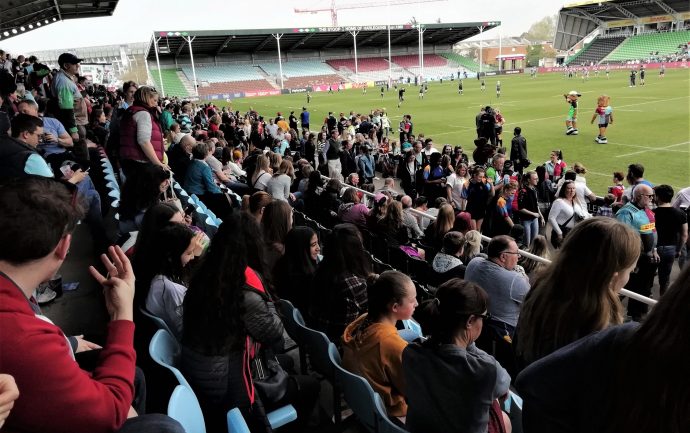Harlequins women have set the pace in attracting larger gates at their matches. At successive ‘Game Changers’ (2018-9) they attracted 4,542 then 4,837 spectators, two great achievements. Yet in Round 9 of this season’s Tyrrells a mere 1,198 turned up to their most crucial home fixture against Saracens.
All the other nine clubs would be delighted to welcome such a crowd, but the question remains: where did the missing 3,639 all go?
This shows the challenge that faces women’s rugby in raising its profile and attracting bigger audiences. At test level the great aim is a five-figure gate. This has been reached at the last three World Cup finals, as we would all hope and expect. But beyond these special occasions it has proved hard to attain.
The French lead the way in bringing large crowds to their games. They are now frequently reaching that target with a record of 17,440 at Grenoble last year.
The RFU has reacted by adjusting its policy. Grounds in London and the home counties (Esher, Allianz Park, Twickenham Stoop and Twickenham Stadium) are no longer the only venues for Red Rose internationals. The first visit to Exeter this year brought an attendance of 10,545 for the 6-Nations game against Italy. Interestingly, when a second test was played there – an autumn international against stronger opponents, France – the total just failed to reach the magical five figures. It was another massive achievement for Exeter Chiefs. These figures reminded the RFU that a local club and its community are far better placed to gain this momentum than London.
How do we explain the consistently disappointing totals reached in the capital? In recent years gates there have remained obstinately below 5,000, several times way below.
Two other clubs have entertained England in the last year, Doncaster and Bedford. Crowds of no more than 5,000 filled the grounds and created a wonderful atmosphere. That is the great dilemma. Those 5,000 would be lost in a stadium as vast as Twickenham. Glorious though an appearance is there for every rugby player, the huge empty spaces create the wrong impression.
What should we be expecting these days?
Other team sports have shown rugby the way. When the England Cricket Board announced a full house at Lord’s for the World Cup final, rugby mouths dropped in wonder – though it must be admitted the ground did not look full to the rafters.
Then it was football’s turn. England women ran out at Wembley to a vast audience, a few times bigger than the Lord’s total.
So the willingness is there. Perhaps it’s a matter of the subtle sell. England Hockey is returning to the Stoop for a second visit. It’s an irony that first time round they charged a minimum of £34 for a ticket to watch both a men’s and a women’s international. Most rugby spectators don’t have to fork out more than £10. Is there truth in the rumour that the more you charge, the more tickets you sell?
When the RFU/Tyrrells announced total attendances at the end of last season – 345 spectators per match – you had to wonder how they made their calculations. Not every club checks every entrance to every game. Rugby authorities do tend to massage their stats by including home viewers via TV or livestream and social media involvement. But there’s a huge difference between sofa-bound interest and attendance at games.
The RFU didn’t cover themselves in glory when they flashed up a precise attendance at the 2019 Scotland game at Twickenham. They had no means of knowing who had stayed behind from the men’s game and who wandered in later to watch the women’s game; but they claimed 13,278. In previous years the attendance was wisely offered in very round figures (12,000/10,000).
At a Tyrrells match I have an acid test: if I fail to become aware of friends or family relations of a player, then I know there’s a decent crowd in the ground. But all too often their presence is evident. Players are grateful to have them there, but it’s essential for the game to attract a much wider audience.
The more it can pay its own way, the quicker financial support and sponsorship will come in from other sources.









